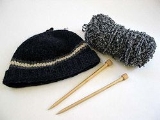
Knitting
Encyclopedia

Yarn
Yarn is a long continuous length of interlocked fibres, suitable for use in the production of textiles, sewing, crocheting, knitting, weaving, embroidery and ropemaking. Thread is a type of yarn intended for sewing by hand or machine. Modern manufactured sewing threads may be finished with wax or...
may be turned into cloth or other fine crafts. Knitted fabric consists of consecutive rows of loops, called stitches. As each row progresses, a new loop is pulled through an existing loop. The active stitches are held on a needle
Knitting needle
A knitting needle or knitting pin is a tool in hand-knitting to produce knitted fabrics. They generally have a long shaft and taper at their end, but they are not nearly as sharp as sewing needles. Their purpose is two-fold...
until another loop can be passed through them. This process eventually results in a final product, often a garment.
Knitting may be done by hand or by machine
Knitting machine
A knitting machine is a device used to create knitted fabrics in a semi- or fully automated fashion.There are numerous types of knitting machines, ranging from the simple, non-mechanical, to the highly complex and electronic. All, however, produce various types of knitted fabrics, usually either...
. There exist numerous styles and methods of hand knitting.
Different yarns and knitting needles may be used to achieve different end products by giving the final piece a different colour, texture, weight, and/or integrity. Using needles of varying sharpness and thickness as well as different varieties of yarn can also change the effect.
Courses and wales
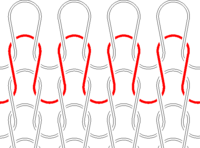
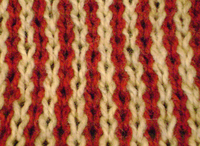
Weaving
Weaving is a method of fabric production in which two distinct sets of yarns or threads are interlaced at right angles to form a fabric or cloth. The other methods are knitting, lace making and felting. The longitudinal threads are called the warp and the lateral threads are the weft or filling...
, knitting is a technique for producing a two-dimensional fabric made from a one-dimensional yarn
Yarn
Yarn is a long continuous length of interlocked fibres, suitable for use in the production of textiles, sewing, crocheting, knitting, weaving, embroidery and ropemaking. Thread is a type of yarn intended for sewing by hand or machine. Modern manufactured sewing threads may be finished with wax or...
or thread. In weaving, threads are always straight, running parallel either lengthwise (warp threads) or crosswise (weft threads). By contrast, the yarn in knitted fabrics follows a meandering path (a course), forming symmetric loops (also called bights) symmetrically above and below the mean path of the yarn. These meandering loops can be stretched easily in different directions, which gives knitting much more elasticity than woven fabrics; depending on the yarn and knitting pattern, knitted garments can stretch as much as 500%. For this reason, knitting was initially developed for garments that must be elastic or stretch in response to the wearer's motions, such as socks and hosiery. For comparison, woven garments stretch mainly along one direction (the bias) and are not very elastic, unless they are woven from stretchable material such as spandex
Spandex
Spandex or elastane is a synthetic fibre known for its exceptional elasticity. It is strong, but less durable than natural Latex, its major non-synthetic competitor. It is a polyurethane-polyurea copolymer that was co-invented in 1959 by chemists C. L. Sandquist and Joseph Shivers at DuPont's...
. Knitted garments are often more form-fitting than woven garments, since their elasticity allows them to follow the body's curvature closely; by contrast, curvature is introduced into most woven garments only with sewn darts, flares, gussets and gores, the seams of which lower the elasticity of the woven fabric still further. Extra curvature can be introduced into knitted garments without seams, as in the heel of a sock; the effect of darts, flares, etc. can be obtained with short rows
Short row (knitting)
In knitting, a short row is a row that is not fully knitted; the work is turned before reaching the end of the row. Just before the work is turned, the yarn is generally passed around the next unknitted stitch to prevent a hole from forming at the turning point.The typical bobble provides a simple...
or by increasing
Increase (knitting)
In knitting, an increase is the creation of one or more new stitches, which may be done by various methods with distinctive looks.-Methods of Single Increasing :...
or decreasing
Decrease (knitting)
A decrease in knitting is a reduction in the number of stitches, usually accomplished by suspending the stitch to be decreased from another existing stitch or by knitting it together with another stitch.-Methods of Single Decreasing :...
the number of stitches. Thread used in weaving is usually much finer than the yarn used in knitting, which can give the knitted fabric more bulk and less drape than a woven fabric.
If they are not secured, the loops of a knitted course will come undone when their yarn is pulled; this is known as ripping out, unravelling knitting, or humorously, frogging (because you 'rip it', this sounds like a frog croaking: 'rib-bit'). To secure a stitch, at least one new loop is passed through it. Although the new stitch is itself unsecured ("active" or "live"), it secures the stitch(es) suspended from it. A sequence of stitches in which each stitch is suspended from the next is called a wale. To secure the initial stitches of a knitted fabric, a method for casting on
Casting on (knitting)
In knitting, casting on is a family of techniques for adding new stitches that do not depend on earlier stitches, i.e., stitches having an independent lower edge. In principle, casting on is the opposite of binding off, but the techniques involved are generally unrelated.Casting on can also be...
is used; to secure the final stitches in a wale, one uses a method of binding off
Binding off (knitting)
In knitting, binding off, or casting off, is a family of techniques for ending a column of stitches. Binding off is typically used to define the final edge of a knitted fabric, although it may also be used in other contexts, e.g., in making button holes...
. During knitting, the active stitches are secured mechanically, either from individual hooks (in knitting machines) or from a knitting needle or frame in hand-knitting.
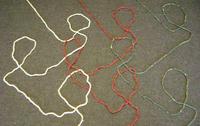
Weft and warp knitting
There are two major varieties of knitting: weft knitting and warp knittingWarp knitting
Warp knitting is a family of knitting methods in which the yarn zigzags along the length of the fabric, i.e., following adjacent columns of knitting, rather than a single row...
. In the more common weft knitting, the wales are perpendicular to the course of the yarn. In warp knitting
Warp knitting
Warp knitting is a family of knitting methods in which the yarn zigzags along the length of the fabric, i.e., following adjacent columns of knitting, rather than a single row...
, the wales and courses run roughly parallel. In weft knitting, the entire fabric may be produced from a single yarn, by adding stitches to each wale in turn, moving across the fabric as in a raster scan
Raster scan
A raster scan, or raster scanning, is the rectangular pattern of image capture and reconstruction in television. By analogy, the term is used for raster graphics, the pattern of image storage and transmission used in most computer bitmap image systems...
. By contrast, in warp knitting, one yarn is required for every wale. Since a typical piece of knitted fabric may have hundreds of wales, warp knitting is typically done by machine, whereas weft knitting is done by both hand and machine. Warp-knitted fabrics such as tricot and milanese are resistant to runs, and are commonly used in lingerie
Lingerie
Lingerie are fashionable and possibly alluring undergarments.Lingerie usually incorporates one or more flexible, stretchy materials like Lycra, nylon , polyester, satin, lace, silk and sheer fabric which are not typically used in more functional, basic cotton undergarments.The term in the French...
.
Weft-knit fabrics may also be knit with multiple yarns, usually to produce interesting color patterns. The two most common approaches are intarsia
Intarsia (knitting)
Intarsia is a knitting technique used to create patterns with multiple colours. As with the woodworking technique of the same name, fields of different colours and materials appear to be inlaid in one another, but are in fact all separate pieces, fit together like a jigsaw puzzle.Unlike other...
and stranded colorwork
Fair Isle (technique)
thumb|Fair Isle [[sweater|jumper]] done in the traditional style, from Fair Isle.Fair Isle is a traditional knitting technique used to create patterns with multiple colours. It is named after Fair Isle, a tiny island in the north of Scotland, that forms part of the Shetland islands...
. In intarsia, the yarns are used in well-segregated regions, e.g., a red apple on a field of green; in that case, the yarns are kept on separate spools and only one is knitted at any time. In the more complex stranded approach, two or more yarns alternate repeatedly within one row and all the yarns must be carried along the row, as seen in Fair Isle sweaters
Fair Isle (technique)
thumb|Fair Isle [[sweater|jumper]] done in the traditional style, from Fair Isle.Fair Isle is a traditional knitting technique used to create patterns with multiple colours. It is named after Fair Isle, a tiny island in the north of Scotland, that forms part of the Shetland islands...
. Double knitting
Double knitting
Double knitting is a form of knitting in which two fabrics are knit simultaneously with two yarns on one pair of needles. The fabrics may be inseparable, as in interlock knitted fabrics, or they can simply be two unconnected fabrics...
can produce two separate knitted fabrics simultaneously, e.g., two socks; however, the two fabrics are usually integrated into one, giving it great warmth and excellent drape.
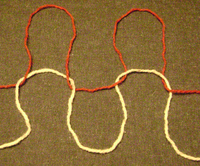
Knit and purl stitches
In securing the previous stitch in a wale, the next stitch can pass through the previous loop from either below or above. If the former, the stitch is denoted as a knit stitch or a plain stitch; if the latter, as a purl stitch. The two stitches are related in that a knit stitch seen from one side of the fabric appears as a purl stitch on the other side.The two types of stitches have a different visual effect; the knit stitches look like "V"'s stacked vertically, whereas the purl stitches look like a wavy horizontal line across the fabric. Patterns and pictures can be created in knitted fabrics by using knit and purl stitches as "pixel
Pixel
In digital imaging, a pixel, or pel, is a single point in a raster image, or the smallest addressable screen element in a display device; it is the smallest unit of picture that can be represented or controlled....
s"; however, such pixels are usually rectangular, rather than square, depending on the gauge of the knitting
Gauge (knitting)
In knitting, the word gauge is used both in hand knitting and machine knitting; the latter, technical abbreviation GG, refers to "Knitting Machines" fineness size. In both cases, the term refers to the number of stitches per inch, not the size of the finished garment...
. Individual stitches, or rows of stitches, may be made taller by drawing more yarn into the new loop (an elongated stitch
Elongated stitch (knitting)
In knitting, an elongated stitch is a stitch that is longer than others. It may be created by wrapping the yarn around the righthand needle two or more times, or by placing yarn overs between stitches and dropping them on the next row.-References:...
), which is the basis for uneven knitting: a row of tall stitches may alternate with one or more rows of short stitches for an interesting visual effect. Short and tall stitches may also alternate within a row, forming a fish-like oval pattern.
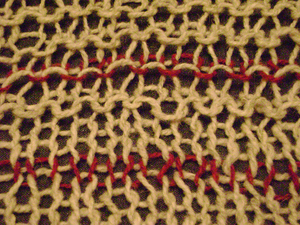
Ribbing (knitting)
In knitting, ribbing is a pattern in which vertical stripes of stockinette stitch alternate with vertical stripes of reverse stockinette stitch...
) are possible by having alternating wales of knit and purl stitches; for example, a common choice is 2x2 ribbing, in which two wales of knit stitches are followed by two wales of purl stitches, etc. Horizontal striping (welting
Welting (knitting)
In knitting, welting is the horizontal analog of ribbing; that is, one or more horizontal rows of knit stitches alternating with one or more rows of purl stitches....
) is also possible, by alternating rows of knit and purl stitches; the simplest of these is garter stitch, so-called because its great elasticity made it well-suited for garters. Checkerboard patterns (basketweave
Basketweave (knitting)
In knitting, a basketweave pattern is characterized by intersecting ribs and welts.In its simplest form, basketweave is composed of a checkerboard pattern of identical rectangles that alternate between stockinette stitch and reverse stockinette stitch...
) are also possible, the smallest of which is known as seed stitch: the stitches alternate between knit and purl in every wale and along every row.
Fabrics in which the number of knit and purl stitches are not the same, such as stockinette, have a tendency to curl; by contrast, those in which knit and purl stitches are arranged symmetrically (such as ribbing, garter stitch or seed stitch) tend to lie flat and drape well. Wales of purl stitches have a tendency to recede, whereas those of knit stitches tend to come forward. Thus, the purl wales in ribbing tend to be invisible, since the neighboring knit wales come forward. Conversely, rows of purl stitches tend to form an embossed ridge relative to a row of knit stitches. This is the basis of shadow knitting
Shadow knitting
Shadow knitting, also called "illusion knitting", is a knitting technique that produces patterns that vary with the direction of viewing.- Method :...
, in which the appearance of a knitted fabric changes when viewed from different directions.
Typically, a new stitch is passed through a single unsecured ("active") loop, thus lengthening that wale by one stitch. However, this need not be so; the new loop may be passed through an already secured stitch lower down on the fabric, or even between secured stitches (a dip stitch
Dip stitch (knitting)
In knitting, a dip stitch is made by knitting into a stitch of an earlier row.The most common type of dip stitch is to knit into the row below, which may be used for visual effect or to increase the number of stitches...
). Depending on the distance between where the loop is drawn through the fabric and where it is knitted, dip stitches can produce a subtle stippling or long lines across the surface of the fabric, e.g., the lower leaves of a flower. The new loop may also be passed between two stitches in the present row, thus clustering
Gather (knitting)
In knitting, a gather is a generic term for the several methods that draw stitches closer together laterally, i.e., within a row of knitting. Common methods include:...
the intervening stitches; this approach is often used to produce a smocking
Smocking
Smocking is an embroidery technique used to gather fabric so that it can stretch. Before elastic, smocking was commonly used in cuffs, bodices, and necklines in garments where buttons were undesirable. Smocking developed in England and has been practised since the Middle Ages and is unusual among...
effect in the fabric. The new loop may also be passed through two or more previous stitches, producing a decrease
Decrease (knitting)
A decrease in knitting is a reduction in the number of stitches, usually accomplished by suspending the stitch to be decreased from another existing stitch or by knitting it together with another stitch.-Methods of Single Decreasing :...
and merging wales together. The merged stitches need not be from the same row; for example, a tuck can be formed by knitting stitches together from two different rows, producing a raised horizontal welt on the fabric.
Not every stitch in a row need be knitted; some may be left as is and knitted on a subsequent row. This is known as slip-stitch knitting
Slip-stitch knitting
Slip-stitch knitting is a family of knitting techniques that use slip stitches to make multiple fabrics simultaneously, to make extra-long stitches, and/or to carry over colors from an earlier row.-Basic methods:...
. The slipped stitches are naturally longer than the knitted ones. For example, a stitch slipped for one row before knitting would be roughly twice as tall as its knitted counterparts. This can produce interesting visual effects, although the resulting fabric is more rigid, because the slipped stitch "pulls" on its neighbours and is less deformable. Slip-stitch knitting plays an important role in mosaic knitting, an important technique in hand-knitting patterned fabrics; mosaic-knit fabrics tend to be stiffer than patterned fabrics produced by other methods such as Fair-Isle knitting
Fair Isle (technique)
thumb|Fair Isle [[sweater|jumper]] done in the traditional style, from Fair Isle.Fair Isle is a traditional knitting technique used to create patterns with multiple colours. It is named after Fair Isle, a tiny island in the north of Scotland, that forms part of the Shetland islands...
.
In some cases, a stitch may be deliberately left unsecured by a new stitch and its wale allowed to disassemble. This is known as drop-stitch knitting
Drop-stitch knitting
Drop-stitch knitting is a knitting technique for producing open, vertical stripes in a garment. The basic idea is to knit a solid fabric, then drop one or more stitches , producing a run in the fabric...
, and produces a vertical ladder of see-through holes in the fabric, corresponding to where the wale had been.


Right- and left-plaited stitches
Both knit and purl stitches may be twisted: usually once if at all, but sometimes twice and (very rarely) thrice. When seen from above, the twist can be clockwise (right yarn over left) or counterclockwise (left yarn over right); these are denoted as right- and left-plaited stitches, respectively. Hand-knitters generally produce right-plaited stitches by knitting or purling through the back loops, i.e., passing the needle through the initial stitch in an unusual way, but wrapping the yarn as usual. By contrast, the left-plaited stitch is generally formed by hand-knitters by wrapping the yarn in the opposite way, rather than by any change in the needle. Although they are mirror images in form, right- and left-plaited stitches are functionally equivalent. Both types of plaited stitches give a subtle but interesting visual texture, and tend to draw the fabric inwards, making it stiffer. Plaited stitches are a common method for knitting jewelry from fine metal wire.Edges and joins between fabrics
The initial and final edges of a knitted fabric are known as the cast-onCasting on (knitting)
In knitting, casting on is a family of techniques for adding new stitches that do not depend on earlier stitches, i.e., stitches having an independent lower edge. In principle, casting on is the opposite of binding off, but the techniques involved are generally unrelated.Casting on can also be...
and bound-off
Binding off (knitting)
In knitting, binding off, or casting off, is a family of techniques for ending a column of stitches. Binding off is typically used to define the final edge of a knitted fabric, although it may also be used in other contexts, e.g., in making button holes...
edges. The side edges are known as the selvages
Selvage (knitting)
The selvage of a knitted fabric consists of the stitch that end each row of knitting. Also called selvedge, the term derives from "self-edge". The selvage may be considered finished; it may also be used in seaming garments, or finished and reinforced using crochet or other techniques...
; the word derives from "self-edges", meaning that the stitches do not need to be secured by anything else. Many types of selvages have been developed, with different elastic and ornamental properties.
Vertical and horizontal edges can be introduced within a knitted fabric, e.g., for button holes, by binding off and re-casting on again (horizontal) or by knitting the fabrics on either side of a vertical edge separately.
Two knitted fabrics can be joined by embroidery-based grafting
Grafting (knitting)
In knitting, grafting is the joining of two knitted fabrics using yarn and a needle in one of three types of seams:# selvage-to-selvage seam,# selvage-to-end seam, or# end-to-end seam...
methods, most commonly the Kitchener stitch. New wales can be begun from any of the edges of a knitted fabric; this is known as picking up stitches
Pick up stitches (knitting)
In knitting, picking up stitches means adding stitches to the knitting needle that were previously bound off or belong to the selvage.Picking up stitches is commonly done in knitting garments, e.g. in knitting the collar or sleeves...
and is the basis for entrelac
Entrelac
Entrelac is a knitting technique used to create a textured diamond pattern. While the end result resembles basket-woven strips of knitted fabric, the actual material comprises interconnected squares on two different orientations....
, in which the wales run perpendicular to one another in a checkerboard pattern.
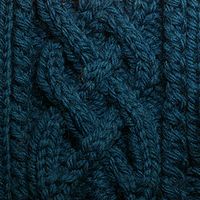
Cables, increases, and lace
Ordinarily, stitches are knitted in the same order in every row, and the wales of the fabric run parallel and vertically along the fabric. However, this need not be so. The order in which stitches are knitted may be permuted so that wales cross over one another, forming a cable pattern. Cables patterns tend to draw the fabric together, making it denser and less elastic; Aran sweaterAran sweater
The Aran sweater is a style of jumper/sweater that takes its name from the Aran Islands off the west coast of Ireland. It is sometimes known as a fisherman sweater...
s are a common form of knitted cabling. Arbitrarily complex braid patterns can be done in cable knitting
Cable knitting
Cable knitting is a style of knitting in which textures of crossing layers are achieved by permuting stitches. For example, given four stitches appearing on the needle in the order ABCD, one might cross the first two the next two, so that in subsequent rows those stitches appear in the new order...
, with the proviso that the wales must move ever upwards; it is generally impossible for a wale to move up and then down the fabric. Knitters have developed methods for giving the illusion of a circular wale, such as appear in Celtic knot
Celtic knot
Celtic knots are a variety of knots and stylized graphical representations of knots used for decoration, used extensively in the Celtic style of Insular art. These knots are most known for their adaptation for use in the ornamentation of Christian monuments and manuscripts, such as the 8th-century...
s, but these are inexact approximations. However, such circular wales are possible using Swiss darning, a form of embroidery, or by knitting a tube separately and attaching it to the knitted fabric.
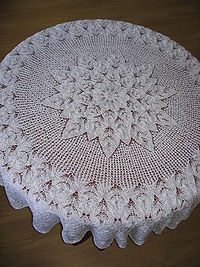
Increase (knitting)
In knitting, an increase is the creation of one or more new stitches, which may be done by various methods with distinctive looks.-Methods of Single Increasing :...
, most commonly involving a yarn over
Yarn over
In knitting, a yarn over is technique in which the yarn is passed over the right-hand knitting needle. In general, the new loop is knitted on the next row, either by itself or together with an adjacent stitch . The yarn-over may also be dropped on the next row, producing a longer stretch of yarn...
. Depending on how the increase is done, there is often a hole in the fabric at the point of the increase. This is used to great effect in lace knitting
Lace knitting
Lace knitting is a style of knitting characterized by stable "holes" in the fabric arranged with consideration of aesthetic value. Lace is sometimes considered the pinnacle of knitting, because of its complexity and because woven fabrics cannot easily be made to have holes...
, which consists of making patterns and pictures using such holes, rather than with the stitches themselves. The large and many holes in lacy knitting makes it extremely elastic; for example, some Shetland "wedding-ring" shawls are so fine that they may be drawn through a wedding ring.
By combining increases and decreases, it is possible to make the direction of a wale slant away from vertical, even in weft knitting. This is the basis for bias knitting
Bias knitting
Bias knitting is a method by which the grain of a knitted fabric is skewed from the vertical, by decreasing on one side and increasing on the other...
, and can be used for visual effect, similar to the direction of a brush-stroke in oil painting.
Ornamentations and additions
Various point-like ornaments may be added to knitting for their look or to improve the wear of the fabric. Examples include various types of bobblesBobble (knitting)
In knitting, a bobble is a localized set of stitches forming a raised bump. The bumps are usually arranged in a regular geometrical pattern or may be figurative, e.g., represent apples on a knitted tree....
, sequins and beads
Bead knitting
Beaded knitting is a type of knitting in which the stitches are decorated with ceramic or glass beads. Important advantages include the surface and color effects available with beads and the longer wear of the beads may lengthen the life of the knitted fabric significantly.The techniques are...
. Long loops can also be drawn out and secured, forming a "shaggy" texture to the fabric; this is known as loop knitting
Loop knitting
In loop knitting, long, dangling loops are introduced into the middle of a knitted fabric or along an edge . The loops may appear singly or in large clusters. An overall array of such loops may be used to give a "shaggy" look to the fabric and/or make it warmer, e.g., tufting the inside of mittens...
. Additional patterns can be made on the surface of the knitted fabric using embroidery
Embroidery
Embroidery is the art or handicraft of decorating fabric or other materials with needle and thread or yarn. Embroidery may also incorporate other materials such as metal strips, pearls, beads, quills, and sequins....
; if the embroidery resembles knitting, it is often called Swiss darning. Various closures for the garments, such as frogs and buttons can be added; usually buttonholes are knitted into the garment, rather than cut.
Ornamental pieces may also be knitted separately and then attached using applique
Applique
In its broadest sense, an appliqué is a smaller ornament or device applied to another surface. In the context of ceramics, for example, an appliqué is a separate piece of clay added to the primary work, generally for the purpose of decoration...
. For example, differently colored leaves and petals of a flower could be knit separately and applied to form the final picture. Separately knitted tubes can be applied to a knitted fabric to form complex Celtic knot
Celtic knot
Celtic knots are a variety of knots and stylized graphical representations of knots used for decoration, used extensively in the Celtic style of Insular art. These knots are most known for their adaptation for use in the ornamentation of Christian monuments and manuscripts, such as the 8th-century...
s and other patterns that would be difficult to knit.
Unknitted yarns may be worked into knitted fabrics for warmth, as is done in tufting
Tufting
Tufting is a type of textile weaving in which a thread is inserted on a primary base.It is an ancient technique for making warm garments, especially mittens. After the knitting is done, short U-shaped loops of extra yarn are introduced through the fabric from the outside so that their ends point...
and "weaving
Weaving (knitting)
In knitting, weaving is a family of techniques for introducing extra yarn into a knitted fabric without knitting them. The extra yarns almost always follow the horizontal rows of knitting and, if visible, resemble a woven texture. Thus, with sufficient force, a woven yarn can be pulled out of a...
" (also known as "couching").
Types

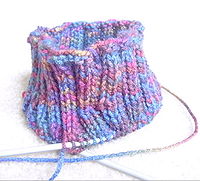
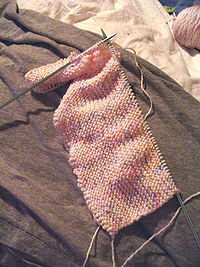
Flat knitting versus circular knitting
Circular knitting (also called "knitting in the round") is a form of knitting that can be used to create a seamless tube. Knitting is worked in rounds (the equivalent of rows in flat knitting) in a helix. Originally, circular knitting was done using a set of four or five double-pointed knitting needleKnitting needle
A knitting needle or knitting pin is a tool in hand-knitting to produce knitted fabrics. They generally have a long shaft and taper at their end, but they are not nearly as sharp as sewing needles. Their purpose is two-fold...
s. Later, circular needles were invented. A circular needle resembles two short knitting needles connected by a cable between them. Flat knitting, on the other hand, is used, in its most basic form, to make flat, rectangular pieces of cloth. It is done with two straight knitting needles and is worked in rows, horizontal lines of stitches. A circular knitting needle can also be used to create flat-knitted pieces that are too large for ordinary straight knitting needles, such as afghans and blankets.
Circular knitting is employed to create pieces that are circular or tube-shaped, such as hat
Hat
A hat is a head covering. It can be worn for protection against the elements, for ceremonial or religious reasons, for safety, or as a fashion accessory. In the past, hats were an indicator of social status...
s, sock
Sock
A sock is an item of clothing worn on the feet. The foot is among the heaviest producers of sweat in the body, as it is able to produce over of perspiration per day. Socks help to absorb this sweat and draw it to areas where air can evaporate the perspiration. In cold environments, socks decrease...
s, mittens, and sleeve
Sleeve
Sleeve is that part of a garment which covers the arm, or through which the arm passes or slips. The pattern of the sleeve is one of the characteristics of fashion in dress, varying in every country and period...
s. Flat knitting is usually used to knit flat pieces like scarves
Scarf
A scarf is a piece of fabric worn around the neck, or near the head or around the waist for warmth, cleanliness, fashion or for religious reasons. They can come in a variety of different colours.-History:...
, blanket
Blanket
A blanket is a type of bedding, generally speaking, a large piece of cloth, intended to keep the user warm, especially while sleeping. Blankets are distinguished from sheets by their thickness and purpose; the thickest sheet is still thinner than the lightest blanket. Blankets are generally used...
s, afghan
Afghan blanket
An afghan is a blanket, wrap, or shawl of colored yarn. It is knitted or crocheted, often in geometric shapes. It can also be referred to as a "throw". Afghans were first made in Afghanistan and commonly featured geometric designs with many holes in the pattern. They are hand-stitched or knitted...
s, and the backs and fronts of sweater
Sweater
A sweater, jumper, pullover, sweatshirt, jersey or guernsey is a garment intended to cover the torso and arms. It is often worn over a shirt, blouse, T-shirt, or other top, but may also be worn alone as a top...
s.
There is also such a thing as finger knitting
Finger knitting
Finger knitting is a simple form of knitting in which yarn is knitted into a shorter but thicker twine. As its name suggests, the knitting only uses the hands during the entire process.-Uses:...
. Instead of needles, fingers are used to produce a tube of knitted fabric.
Felting
Felting is the hand-knitters' term for fullingFulling
Fulling or tucking or walking is a step in woolen clothmaking which involves the cleansing of cloth to eliminate oils, dirt, and other impurities, and making it thicker. The worker who does the job is a fuller, tucker, or walker...
, a technique for joining knitted or woven wool fibres. The finished product is put in a hot wash and is agitated until it shrinks. While the knitted project is in the washing machine, it is important to check the progress. Depending on the size of the project, some may felt faster than others. The end result typically has reduced dimensions. Bags, mittens, socks and hats are just a few ideas of items that could be felted.
Needle felting
Needle felting is a technique used to add decoration to a knitted or felted piece, where raw roving is applied using a very sharp barbed felting needle by repeatedly piercing the roving and background together. Once washed in hot water, the appliqued decoration is fused with the background. Felted knitting can be cut with scissors without concern about fraying.History and culture
The word is derived from knot, thought to originate from the DutchDutch language
Dutch is a West Germanic language and the native language of the majority of the population of the Netherlands, Belgium, and Suriname, the three member states of the Dutch Language Union. Most speakers live in the European Union, where it is a first language for about 23 million and a second...
verb knutten, which is similar to the Old English cnyttan, to knot.
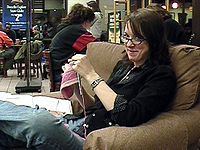
Egypt
Egypt , officially the Arab Republic of Egypt, Arabic: , is a country mainly in North Africa, with the Sinai Peninsula forming a land bridge in Southwest Asia. Egypt is thus a transcontinental country, and a major power in Africa, the Mediterranean Basin, the Middle East and the Muslim world...
from the end of the first millennium AD. Originally a male-only occupation, the first knitting trade guild was started in Paris in 1527. With the invention of the knitting machine
Knitting machine
A knitting machine is a device used to create knitted fabrics in a semi- or fully automated fashion.There are numerous types of knitting machines, ranging from the simple, non-mechanical, to the highly complex and electronic. All, however, produce various types of knitted fabrics, usually either...
, however, knitting "by hand" became a useful but non-essential craft. Similar to quilting
Quilting
Quilting is a sewing method done to join two or more layers of material together to make a thicker padded material. A quilter is the name given to someone who works at quilting. Quilting can be done by hand, by sewing machine, or by a specialist longarm quilting system.The process of quilting uses...
, spinning
Spinning (textiles)
Spinning is a major industry. It is part of the textile manufacturing process where three types of fibre are converted into yarn, then fabric, then textiles. The textiles are then fabricated into clothes or other artifacts. There are three industrial processes available to spin yarn, and a...
, and needlepoint
Needlepoint
Needlepoint is a form of counted thread embroidery in which yarn is stitched through a stiff open weave canvas. Most needlepoint designs completely cover the canvas...
, knitting became a leisure activity.
Hand-knitting has gone into and out of fashion many times in the last two centuries, and at the turn of the 21st century it is enjoying a revival. According to the industry group Craft Yarn Council of America
Craft Yarn Council of America
The Craft Yarn Council of America is an industry association representing organizations that retail 85% of the crochet and knitting supplies in the USA....
, the number of women knitters in the United States age 25–35 increased 150% in the two years between 2002 and 2004. The latest incarnation is less about the "make-do and mend" attitude of the 1940s and early 50s and more about making a statement about individuality as well as developing an innate sense of community.
Within the 1940s, English knitting
English knitting
English knitting, also known as right-hand knitting or throwing, is a style of Western knitting where the yarn to be knit into the fabric is carried in the right hand...
rose in popularity while Continental knitting fell. This is due to the fact that continental knitting originated within Germany and was spread by immigrants. During World War II
World War II
World War II, or the Second World War , was a global conflict lasting from 1939 to 1945, involving most of the world's nations—including all of the great powers—eventually forming two opposing military alliances: the Allies and the Axis...
, continental knitting fell out of style due to its relationship with Germany. It wasn't until Elizabeth Zimmermann
Elizabeth Zimmermann
Elizabeth Zimmermann was a British-born knitter known for revolutionizing the modern practice of knitting through her books and instructional series on American public television....
publicized continental knitting in the 1980s that it again was popularized.
Additionally, many contemporary knitters have an interest in blogging about their knitting, patterns, and techniques, or joining a virtual community focused on knitting, such as Ravelry
Ravelry
Ravelry is a free social networking website, beta-launched in May 2007. It functions as an organizational tool for a variety of fiber arts including knitting, crocheting, spinning, and weaving. Members share projects, ideas, and their collection of yarn, fiber, and tools via various components...
, affectionately known as Rav to fiber-lovers around the world. There are also a number of popular knitting podcasts, such as the Manic Purl Podcast and the Savvy Girls Podcast. Contemporary knitting groups may be referred to in the U.S. as a "Stitch 'N Bitch" where a group of knitters get together to work on projects, discuss patterns, troubleshoot their work and just socialize. In the UK, the term has been "knitting circle" since the early 20th century.
Properties of fabrics

Topology
Topology is a major area of mathematics concerned with properties that are preserved under continuous deformations of objects, such as deformations that involve stretching, but no tearing or gluing...
of a knitted fabric is relatively complex. Unlike woven
Weaving
Weaving is a method of fabric production in which two distinct sets of yarns or threads are interlaced at right angles to form a fabric or cloth. The other methods are knitting, lace making and felting. The longitudinal threads are called the warp and the lateral threads are the weft or filling...
fabrics, where strands usually run straight horizontally and vertically, yarn that has been knitted follows a loopy path along its row, as with the red strand in the diagram at left, in which the loops of one row have all been pulled through the loops of the row below it.
Because there is no single straight line of yarn anywhere in the pattern, a knitted piece can stretch in all directions. This elasticity is unavailable from woven fabrics, which only stretch along the bias
Bias (textile)
The bias or cross-grain direction of a piece of woven fabric, usually referred to simply as "the bias" or "the cross-grain", is at 45 degrees to its warp and weft threads. Every piece of woven fabric has two biases, perpendicular to each other...
. Many modern stretchy garments, even as they rely on elastic synthetic materials for some stretch, also achieve at least some of their stretch through knitted patterns.
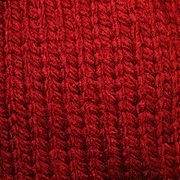
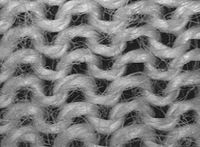
Basic knitted fabrics
A few types of knitted fabric are so fundamental that they have been adopted as part of the language of knitting, similar to techniques such as yarn over or decrease...
pattern) has a definite "right side" and "wrong side"
Flat knitting
Flat knitting is a method for producing knitted fabrics in which the work is turned periodically, i.e., the fabric is knitted from alternating sides...
. On the right side, the visible portions of the loops are the verticals connecting two rows, arranged in a grid of V shapes. On the wrong side, the ends of the loops are visible, both the tops and bottoms, creating a much more bumpy texture sometimes called reverse stockinette
Basic knitted fabrics
A few types of knitted fabric are so fundamental that they have been adopted as part of the language of knitting, similar to techniques such as yarn over or decrease...
. (Despite being the "wrong side," reverse stockinette is frequently used as a pattern in its own right.) Because the yarn holding rows together is all on the front, and the yarn holding side-by-side stitches together is all on the back, stockinette fabric
Basic knitted fabrics
A few types of knitted fabric are so fundamental that they have been adopted as part of the language of knitting, similar to techniques such as yarn over or decrease...
has a strong tendency to curl toward the front on the top and bottom, and toward the back on the left and right side.
Stitches can be worked from either side, and various patterns are created by mixing regular knit stitches with the "wrong side" stitches, known as purl stitches, either in columns (ribbing
Ribbing (knitting)
In knitting, ribbing is a pattern in which vertical stripes of stockinette stitch alternate with vertical stripes of reverse stockinette stitch...
), rows (garter
Basic knitted fabrics
A few types of knitted fabric are so fundamental that they have been adopted as part of the language of knitting, similar to techniques such as yarn over or decrease...
, welting
Welting (knitting)
In knitting, welting is the horizontal analog of ribbing; that is, one or more horizontal rows of knit stitches alternating with one or more rows of purl stitches....
), or more complex patterns. Each such fabric has different properties: a garter stitch
Basic knitted fabrics
A few types of knitted fabric are so fundamental that they have been adopted as part of the language of knitting, similar to techniques such as yarn over or decrease...
has much more vertical stretch, while ribbing
Ribbing (knitting)
In knitting, ribbing is a pattern in which vertical stripes of stockinette stitch alternate with vertical stripes of reverse stockinette stitch...
stretches much more horizontally. Because of their front-back symmetry
Symmetry
Symmetry generally conveys two primary meanings. The first is an imprecise sense of harmonious or aesthetically pleasing proportionality and balance; such that it reflects beauty or perfection...
, these two fabrics have little curl, making them popular as edging, even when their stretch properties are not desired.
Different combinations of knit and purl stitches, along with more advanced techniques, generate fabrics of considerably variable consistency, from gauzy to very dense, from highly stretchy to relatively stiff, from flat to tightly curled, and so on.
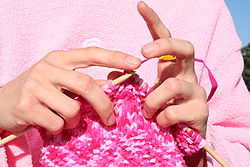
Texture
The most common texture for a knitted garment is that generated by the flat stockinette stitchBasic knitted fabrics
A few types of knitted fabric are so fundamental that they have been adopted as part of the language of knitting, similar to techniques such as yarn over or decrease...
—as seen, though very small, in machine-made stockings and T-shirt
T-shirt
A T-shirt is a style of shirt. A T-shirt is buttonless and collarless, with short sleeves and frequently a round neck line....
s—which is worked in the round as nothing but knit stitches, and worked flat as alternating rows of knit and purl. Other simple textures can be made with nothing but knit and purl stitches, including garter stitch
Basic knitted fabrics
A few types of knitted fabric are so fundamental that they have been adopted as part of the language of knitting, similar to techniques such as yarn over or decrease...
, ribbing
Ribbing (knitting)
In knitting, ribbing is a pattern in which vertical stripes of stockinette stitch alternate with vertical stripes of reverse stockinette stitch...
, and moss and seed stitches
Basic knitted fabrics
A few types of knitted fabric are so fundamental that they have been adopted as part of the language of knitting, similar to techniques such as yarn over or decrease...
. Adding a "slip stitch" (where a loop is passed from one needle to the other) allows for a wide range of textures, including heel and linen stitches, and a number of more complicated patterns.
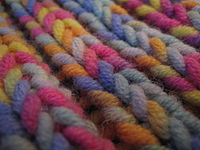
Increase (knitting)
In knitting, an increase is the creation of one or more new stitches, which may be done by various methods with distinctive looks.-Methods of Single Increasing :...
, which can create small eyelet holes in the resulting fabric, with assorted decreases
Decrease (knitting)
A decrease in knitting is a reduction in the number of stitches, usually accomplished by suspending the stitch to be decreased from another existing stitch or by knitting it together with another stitch.-Methods of Single Decreasing :...
is key to creating knitted lace
Lace knitting
Lace knitting is a style of knitting characterized by stable "holes" in the fabric arranged with consideration of aesthetic value. Lace is sometimes considered the pinnacle of knitting, because of its complexity and because woven fabrics cannot easily be made to have holes...
, a very open fabric resembling lace
Lace
Lace is an openwork fabric, patterned with open holes in the work, made by machine or by hand. The holes can be formed via removal of threads or cloth from a previously woven fabric, but more often open spaces are created as part of the lace fabric. Lace-making is an ancient craft. True lace was...
. Changing the order of stitches from one row to the next, usually with the help of a cable needle or stitch holder
Stitch holder
Stitch holders are tools that are used by knitters to hold open stitches when not being used by the needles.They can be used when finishing a side of an item, such as a sweater, and preparing for the kitchener stitch....
, is key to cable knitting
Cable knitting
Cable knitting is a style of knitting in which textures of crossing layers are achieved by permuting stitches. For example, given four stitches appearing on the needle in the order ABCD, one might cross the first two the next two, so that in subsequent rows those stitches appear in the new order...
, producing an endless variety of cables, honeycombs, ropes, and Aran sweater
Aran sweater
The Aran sweater is a style of jumper/sweater that takes its name from the Aran Islands off the west coast of Ireland. It is sometimes known as a fisherman sweater...
patterning. Entrelac
Entrelac
Entrelac is a knitting technique used to create a textured diamond pattern. While the end result resembles basket-woven strips of knitted fabric, the actual material comprises interconnected squares on two different orientations....
forms a rich checkerboard texture by knitting small squares, picking up their side edges, and knitting more squares to continue the piece.
The appearance of a garment is also affected by the weight of the yarn, which describes the thickness of the spun fibre. The thicker the yarn, the more visible and apparent stitches will be; the thinner the yarn, the finer the texture.
Color
Plenty of finished knitting projects never use more than a single color of yarn, but there are many ways to work in multiple colors. Some yarns are dyed to be either variegated (changing color every few stitches in a random fashion) or self-striping (changing every few rows). More complicated techniques permit large fields of color (intarsiaIntarsia (knitting)
Intarsia is a knitting technique used to create patterns with multiple colours. As with the woodworking technique of the same name, fields of different colours and materials appear to be inlaid in one another, but are in fact all separate pieces, fit together like a jigsaw puzzle.Unlike other...
, for example), busy small-scale patterns of color (such as Fair Isle
Fair Isle (technique)
thumb|Fair Isle [[sweater|jumper]] done in the traditional style, from Fair Isle.Fair Isle is a traditional knitting technique used to create patterns with multiple colours. It is named after Fair Isle, a tiny island in the north of Scotland, that forms part of the Shetland islands...
), or both (double knitting
Double knitting
Double knitting is a form of knitting in which two fabrics are knit simultaneously with two yarns on one pair of needles. The fabrics may be inseparable, as in interlock knitted fabrics, or they can simply be two unconnected fabrics...
and slip-stitch color
Slip-stitch knitting
Slip-stitch knitting is a family of knitting techniques that use slip stitches to make multiple fabrics simultaneously, to make extra-long stitches, and/or to carry over colors from an earlier row.-Basic methods:...
, for example).
Yarn with multiple shades of the same hue are called ombre, while a yarn with multiple hues may be known as a given colorway — a green, red and yellow yarn might be dubbed the "Parrot Colorway" by its manufacturer, for example. Heathered yarns contain small amounts of fibre of different colours, while tweed yarns may have greater amounts of different colored fibres.
Process
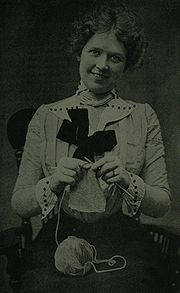
Casting on (knitting)
In knitting, casting on is a family of techniques for adding new stitches that do not depend on earlier stitches, i.e., stitches having an independent lower edge. In principle, casting on is the opposite of binding off, but the techniques involved are generally unrelated.Casting on can also be...
(also known as "binding on"), which involves the initial creation of the stitches on the needle. Different methods of casting on are used for different effects: one may be stretchy enough for lace, while another provides a decorative edging — Provisional cast-ons are used when the knitting will continue in both directions from the cast-on. There are various method employed to "cast on," such as the "thumb method" (also known as "slingshot" or "long-tail" cast-ons), where the stitches are created by a series of loops that will, when knitted, give a very loose edge ideal for "picking up stitches" and knitting a border; the "double needle method" (also known as "knit-on" or "cable cast-on"), whereby each loop placed on the needle is then "knitted on," which produces a firmer edge ideal on its own as a border; and many more. The number of active stitches remains the same as when cast on unless stitches are added (an increase
Increase (knitting)
In knitting, an increase is the creation of one or more new stitches, which may be done by various methods with distinctive looks.-Methods of Single Increasing :...
) or removed (a decrease
Decrease (knitting)
A decrease in knitting is a reduction in the number of stitches, usually accomplished by suspending the stitch to be decreased from another existing stitch or by knitting it together with another stitch.-Methods of Single Decreasing :...
).
Most Western-style knitters follow either the English
English knitting
English knitting, also known as right-hand knitting or throwing, is a style of Western knitting where the yarn to be knit into the fabric is carried in the right hand...
style (in which the yarn is held in the right hand) or the Continental style (in which the yarn is held in the left hand).
There are also different ways to insert the needle into the stitch. Knitting through the front of a stitch is called Western knitting. Going through the back of a stitch is called Eastern knitting. A third method, called combination knitting, goes through the front of a knit stitch and the back of a purl stitch.
Once the knitted piece is finished, the remaining live stitches are "cast off
Binding off (knitting)
In knitting, binding off, or casting off, is a family of techniques for ending a column of stitches. Binding off is typically used to define the final edge of a knitted fabric, although it may also be used in other contexts, e.g., in making button holes...
". Casting (or "binding") off loops the stitches across each other so they can be removed from the needle without unravelling the item. Although the mechanics are different from casting on, there is a similar variety of methods.
In knitting certain articles of clothing, especially larger ones like sweaters, the final knitted garment will be made of several knitted pieces, with individual sections of the garment knit separately and then sewn together
Grafting (knitting)
In knitting, grafting is the joining of two knitted fabrics using yarn and a needle in one of three types of seams:# selvage-to-selvage seam,# selvage-to-end seam, or# end-to-end seam...
. Seamless knitting, where a whole garment is knit as a single piece, is also possible. Elizabeth Zimmermann
Elizabeth Zimmermann
Elizabeth Zimmermann was a British-born knitter known for revolutionizing the modern practice of knitting through her books and instructional series on American public television....
is probably the best-known proponent of seamless or circular knitting techniques. Smaller items, such as socks and hats, are usually knit in one piece on double-pointed needles or circular needles. (See Circular knitting
Circular knitting
Circular knitting or knitting in the round is a form of knitting that creates a seamless tube. When knitting circularly, the knitting is cast on and the circle of stitches is joined. Knitting is worked in rounds in a spiral. Originally, circular knitting was done using a set of four or five...
.)
Yarn
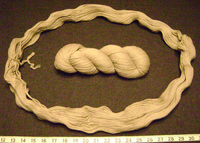
Gauge (knitting)
In knitting, the word gauge is used both in hand knitting and machine knitting; the latter, technical abbreviation GG, refers to "Knitting Machines" fineness size. In both cases, the term refers to the number of stitches per inch, not the size of the finished garment...
, etc. It is common practice to save the yarn band for future reference, especially if additional skeins must be purchased. Knitters generally ensure that the yarn for a project comes from a single dye lot. The dye lot specifies a group of skeins that were dyed together and thus have precisely the same color; skeins from different dye-lots, even if very similar in color, are usually slightly different and may produce a visible stripe when knitted together. If a knitter buys insufficient yarn of a single dye lot to complete a project, additional skeins of the same dye lot can sometimes be obtained from other yarn stores or online. Otherwise, knitters can alternate skeins every few rows to help the dye lots blend together easier.
The thickness or weight of the yarn is a significant factor in determining the gauge
Gauge (knitting)
In knitting, the word gauge is used both in hand knitting and machine knitting; the latter, technical abbreviation GG, refers to "Knitting Machines" fineness size. In both cases, the term refers to the number of stitches per inch, not the size of the finished garment...
, i.e., how many stitches and rows are required to cover a given area for a given stitch pattern. Thicker yarns generally require thicker knitting needles, whereas thinner yarns may be knit with thick or thin needles. Hence, thicker yarns generally require fewer stitches, and therefore less time, to knit up a given garment. Patterns and motifs are coarser with thicker yarns; thicker yarns produce bold visual effects, whereas thinner yarns are best for refined patterns. Yarns are grouped by thickness into six categories: superfine, fine, light, medium, bulky and superbulky; quantitatively, thickness is measured by the number of wraps per inch (WPI). The related weight per unit length is usually measured in tex or dernier
Units of textile measurement
Textile is measured in various units, such as: the denier and tex , super S , worst count, and yield ....
.
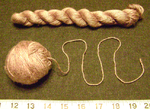
A yarn's usefulness for a knitting project is judged by several factors, such as its loft (its ability to trap air), its resilience (elasticity under tension), its washability
Laundry
Laundry is a noun that refers to the act of washing clothing and linens, the place where that washing is done, and/or that which needs to be, is being, or has been laundered...
and colorfastness, its hand (its feel, particularly softness vs. scratchiness), its durability against abrasion, its resistance to pilling
Pill (textile)
A pill, colloquially known as a bobble, is a small ball of fibres that forms on a piece of cloth from wear. Pill is also a verb for the formation of such balls....
, its hairiness (fuzziness), its tendency to twist or untwist, its overall weight and drape, its blocking and felting qualities, its comfort (breathability, moisture absorption, wicking properties) and of course its look, which includes its color, sheen, smoothness and ornamental features. Other factors include allergenicity; speed of drying; resistance to chemicals, moths, and mildew; melting point and flammability; retention of static electricity; and the propensity to become stained and to accept dyes. Different factors may be more significant than others for different knitting projects, so there is no one "best" yarn. The resilience and propensity to (un)twist are general properties that affect the ease of hand-knitting. More resilient yarns are more forgiving of irregularities in tension
Gauge (knitting)
In knitting, the word gauge is used both in hand knitting and machine knitting; the latter, technical abbreviation GG, refers to "Knitting Machines" fineness size. In both cases, the term refers to the number of stitches per inch, not the size of the finished garment...
; highly twisted yarns are sometimes difficult to knit, whereas untwisting yarns can lead to split stitches, in which not all of the yarn is knitted into a stitch. A key factor in knitting is stitch definition, corresponding to how well complicated stitch patterns can be seen when made from a given yarn. Smooth, highly spun yarns are best for showing off stitch patterns; at the other extreme, very fuzzy yarns or eyelash yarns have poor stitch definition, and any complicated stitch pattern would be invisible.
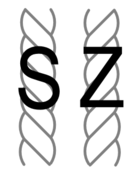
Spinning (textiles)
Spinning is a major industry. It is part of the textile manufacturing process where three types of fibre are converted into yarn, then fabric, then textiles. The textiles are then fabricated into clothes or other artifacts. There are three industrial processes available to spin yarn, and a...
fibers. In spinning, the fibers are twisted so that the yarn resists breaking under tension; the twisting may be done in either direction, resulting in an Z-twist or S-twist yarn. If the fibers are first aligned by combing them, the yarn is smoother and called a worsted; by contrast, if the fibers are carded but not combed, the yarn is fuzzier and called woolen-spun. The fibers making up a yarn may be continuous filament fibers such as silk
Silk
Silk is a natural protein fiber, some forms of which can be woven into textiles. The best-known type of silk is obtained from the cocoons of the larvae of the mulberry silkworm Bombyx mori reared in captivity...
and many synthetics, or they may be staples (fibers of an average length, typically a few inches); naturally filament fibers are sometimes cut up into staples before spinning. The strength of the spun yarn against breaking is determined by the amount of twist, the length of the fibers and the thickness of the yarn. In general, yarns become stronger with more twist (also called worst), longer fibers and thicker yarns (more fibers); for example, thinner yarns require more twist than do thicker yarns to resist breaking under tension. The thickness of the yarn may vary along its length; a slub is a much thicker section in which a mass of fibers is incorporated into the yarn.
The spun fibers are generally divided into animal fiber
Animal fiber
Animal fibers are natural fibers that consist largely of particular proteins. Instances are silk, hair/fur and feathers. The animal fibers used most commonly both in the manufacturing world as well as by the hand spinners are wool from domestic sheep and silk. Also very popular are alpaca fiber...
s, plant and synthetic fiber
Synthetic fiber
Synthetic fibers are the result of extensive research by scientists to improve on naturally occurring animal and plant fibers. In general, synthetic fibers are created by forcing, usually through extrusion, fiber forming materials through holes into the air, forming a thread...
s. These fiber types are chemically different, corresponding to protein
Protein
Proteins are biochemical compounds consisting of one or more polypeptides typically folded into a globular or fibrous form, facilitating a biological function. A polypeptide is a single linear polymer chain of amino acids bonded together by peptide bonds between the carboxyl and amino groups of...
s, carbohydrate
Carbohydrate
A carbohydrate is an organic compound with the empirical formula ; that is, consists only of carbon, hydrogen, and oxygen, with a hydrogen:oxygen atom ratio of 2:1 . However, there are exceptions to this. One common example would be deoxyribose, a component of DNA, which has the empirical...
s and synthetic polymer
Polymer
A polymer is a large molecule composed of repeating structural units. These subunits are typically connected by covalent chemical bonds...
s, respectively. Animal fibers include silk
Silk
Silk is a natural protein fiber, some forms of which can be woven into textiles. The best-known type of silk is obtained from the cocoons of the larvae of the mulberry silkworm Bombyx mori reared in captivity...
, but generally are long hairs of animals such as sheep (wool
Wool
Wool is the textile fiber obtained from sheep and certain other animals, including cashmere from goats, mohair from goats, qiviut from muskoxen, vicuña, alpaca, camel from animals in the camel family, and angora from rabbits....
), goat
Goat
The domestic goat is a subspecies of goat domesticated from the wild goat of southwest Asia and Eastern Europe. The goat is a member of the Bovidae family and is closely related to the sheep as both are in the goat-antelope subfamily Caprinae. There are over three hundred distinct breeds of...
(angora
Angora goat
The Angora goat is a breed of domestic goat that originated in Ankara , Turkey and its surrounding region in central Anatolia...
, or cashmere goat
Cashmere goat
A cashmere goat is any breed of goat that produces cashmere wool, the goat's fine soft downy winter undercoat, in commercial quality and quantity. This undercoat grows as the day length shortens and is associated with an outer coat of coarse hair, which is present all the year and is called guard...
), rabbit
Rabbit
Rabbits are small mammals in the family Leporidae of the order Lagomorpha, found in several parts of the world...
(angora
Angora rabbit
The Angora rabbit is a variety of domestic rabbit bred for its long, soft wool. The Angora is one of the oldest types of domestic rabbit, originating in Ankara , Turkey, along with the Angora cat and Angora goat. The rabbits were popular pets with French royalty in the mid 18th century, and spread...
), llama
Llama
The llama is a South American camelid, widely used as a meat and pack animal by Andean cultures since pre-Hispanic times....
, alpaca
Alpaca
An alpaca is a domesticated species of South American camelid. It resembles a small llama in appearance.Alpacas are kept in herds that graze on the level heights of the Andes of southern Peru, northern Bolivia, Ecuador, and northern Chile at an altitude of to above sea level, throughout the year...
, dog
Dog
The domestic dog is a domesticated form of the gray wolf, a member of the Canidae family of the order Carnivora. The term is used for both feral and pet varieties. The dog may have been the first animal to be domesticated, and has been the most widely kept working, hunting, and companion animal in...
, cat
Cat
The cat , also known as the domestic cat or housecat to distinguish it from other felids and felines, is a small, usually furry, domesticated, carnivorous mammal that is valued by humans for its companionship and for its ability to hunt vermin and household pests...
, camel
Camel
A camel is an even-toed ungulate within the genus Camelus, bearing distinctive fatty deposits known as humps on its back. There are two species of camels: the dromedary or Arabian camel has a single hump, and the bactrian has two humps. Dromedaries are native to the dry desert areas of West Asia,...
, yak
Yak
The yak, Bos grunniens or Bos mutus, is a long-haired bovine found throughout the Himalayan region of south Central Asia, the Tibetan Plateau and as far north as Mongolia and Russia. In addition to a large domestic population, there is a small, vulnerable wild yak population...
, and muskox (qiviut
Qiviut
Qiviut is an Inuit word commonly used to indicate the wool of the muskox. The word was originally used to refer to the down feathers of birds as well as the inner wool of the muskox. It is valued for its use as a fiber as, unlike sheep's wool, it does not shrink in water at any temperature...
). Plants used for fibers include cotton
Cotton
Cotton is a soft, fluffy staple fiber that grows in a boll, or protective capsule, around the seeds of cotton plants of the genus Gossypium. The fiber is almost pure cellulose. The botanical purpose of cotton fiber is to aid in seed dispersal....
, flax
Flax
Flax is a member of the genus Linum in the family Linaceae. It is native to the region extending from the eastern Mediterranean to India and was probably first domesticated in the Fertile Crescent...
(for linen
Linen
Linen is a textile made from the fibers of the flax plant, Linum usitatissimum. Linen is labor-intensive to manufacture, but when it is made into garments, it is valued for its exceptional coolness and freshness in hot weather....
), bamboo
Bamboo
Bamboo is a group of perennial evergreens in the true grass family Poaceae, subfamily Bambusoideae, tribe Bambuseae. Giant bamboos are the largest members of the grass family....
, ramie
Ramie
Ramie is a flowering plant in the nettle family Urticaceae, native to eastern Asia. It is a herbaceous perennial growing to 1–2.5 m tall; the leaves are heart-shaped, 7–15 cm long and 6–12 cm broad, and white on the underside with dense small hairs—this gives it a silvery appearance;...
, hemp
Hemp
Hemp is mostly used as a name for low tetrahydrocannabinol strains of the plant Cannabis sativa, of fiber and/or oilseed varieties. In modern times, hemp has been used for industrial purposes including paper, textiles, biodegradable plastics, construction, health food and fuel with modest...
, jute
Jute
Jute is a long, soft, shiny vegetable fibre that can be spun into coarse, strong threads. It is produced from plants in the genus Corchorus, which has been classified in the family Tiliaceae, or more recently in Malvaceae....
, nettle
Nettle
Nettles constitute between 24 and 39 species of flowering plants of the genus Urtica in the family Urticaceae, with a cosmopolitan though mainly temperate distribution. They are mostly herbaceous perennial plants, but some are annual and a few are shrubby...
, raffia, yucca
Yucca
Yucca is a genus of perennial shrubs and trees in the family Asparagaceae, subfamily Agavoideae. Its 40-50 species are notable for their rosettes of evergreen, tough, sword-shaped leaves and large terminal panicles of white or whitish flowers. They are native to the hot and dry parts of North...
, coconut
Coconut
The coconut palm, Cocos nucifera, is a member of the family Arecaceae . It is the only accepted species in the genus Cocos. The term coconut can refer to the entire coconut palm, the seed, or the fruit, which is not a botanical nut. The spelling cocoanut is an old-fashioned form of the word...
husk, banana trees, soy and corn
Maize
Maize known in many English-speaking countries as corn or mielie/mealie, is a grain domesticated by indigenous peoples in Mesoamerica in prehistoric times. The leafy stalk produces ears which contain seeds called kernels. Though technically a grain, maize kernels are used in cooking as a vegetable...
. Rayon
Rayon
Rayon is a manufactured regenerated cellulose fiber. Because it is produced from naturally occurring polymers, it is neither a truly synthetic fiber nor a natural fiber; it is a semi-synthetic or artificial fiber. Rayon is known by the names viscose rayon and art silk in the textile industry...
and acetate
Cellulose acetate
Cellulose acetate , first prepared in 1865, is the acetate ester of cellulose. Cellulose acetate is used as a film base in photography, as a component in some adhesives, and as a frame material for eyeglasses; it is also used as a synthetic fiber and in the manufacture of cigarette filters and...
fibers are also produced from cellulose
Cellulose
Cellulose is an organic compound with the formula , a polysaccharide consisting of a linear chain of several hundred to over ten thousand β linked D-glucose units....
mainly derived from tree
Tree
A tree is a perennial woody plant. It is most often defined as a woody plant that has many secondary branches supported clear of the ground on a single main stem or trunk with clear apical dominance. A minimum height specification at maturity is cited by some authors, varying from 3 m to...
s. Common synthetic fibers include acrylic
Acrylic fiber
Acrylic fibers are synthetic fibers made from a polymer with an average molecular weight of ~100,000, about 1900 monomer units. To be called acrylic in the U.S, the polymer must contain at least 85% acrylonitrile monomer. Typical comonomers are vinyl acetate or methyl acrylate...
s, polyester
Polyester
Polyester is a category of polymers which contain the ester functional group in their main chain. Although there are many polyesters, the term "polyester" as a specific material most commonly refers to polyethylene terephthalate...
s such as dacron
Polyethylene terephthalate
Polyethylene terephthalate , commonly abbreviated PET, PETE, or the obsolete PETP or PET-P, is a thermoplastic polymer resin of the polyester family and is used in synthetic fibers; beverage, food and other liquid containers; thermoforming applications; and engineering resins often in combination...
and ingeo
Ingeo
Ingeo is the trademark name for NatureWorks LLC's synthetic fiber made from corn.The process to create Ingeo makes use of the carbon stored in plants by photosynthesis. Plant starches are broken down into sugars. The carbon and other elements in these sugars are then used to make a biopolymer...
, nylon
Nylon
Nylon is a generic designation for a family of synthetic polymers known generically as polyamides, first produced on February 28, 1935, by Wallace Carothers at DuPont's research facility at the DuPont Experimental Station...
and other polyamides, and olefins such as polypropylene
Polypropylene
Polypropylene , also known as polypropene, is a thermoplastic polymer used in a wide variety of applications including packaging, textiles , stationery, plastic parts and reusable containers of various types, laboratory equipment, loudspeakers, automotive components, and polymer banknotes...
. Of these types, wool is generally favored for knitting, chiefly owing to its superior elasticity
Elasticity (physics)
In physics, elasticity is the physical property of a material that returns to its original shape after the stress that made it deform or distort is removed. The relative amount of deformation is called the strain....
, warmth and (sometimes) felt
Felt
Felt is a non-woven cloth that is produced by matting, condensing and pressing woollen fibres. While some types of felt are very soft, some are tough enough to form construction materials. Felt can be of any colour, and made into any shape or size....
ing; however, wool is generally less convenient to clean
Laundry
Laundry is a noun that refers to the act of washing clothing and linens, the place where that washing is done, and/or that which needs to be, is being, or has been laundered...
and some people are allergic to it. It is also common to blend different fibers in the yarn, e.g., 85% alpaca and 15% silk. Even within a type of fiber, there can be great variety in the length and thickness of the fibers; for example, Merino
Merino
The Merino is an economically influential breed of sheep prized for its wool. Merinos are regarded as having some of the finest and softest wool of any sheep...
wool and Egyptian cotton
Gossypium barbadense
Gossypium barbadense, also known as extra long staple cotton as it generally has a staple of at least 1 3/8" or longer, is a species of cotton plant. Some types of ELS cotton are American Pima, Egyptian Giza, Indian Suvin, Chinese Xiniang, Sudanese Barakat, and Russian Tonkovoloknistyi...
are favored because they produce exceptionally long, thin (fine) fibers for their type.
A single spun yarn may be knitted as is, or braid
Braid
A braid is a complex structure or pattern formed by intertwining three or more strands of flexible material such as textile fibres, wire, or human hair...
ed or plied
Plying
In the textile arts, plying is a process used to create a strong, balanced yarn. It is done by taking two or more strands of yarn that each have a twist to them and putting them together. The strands are twisted together, in the direction opposite that in which they were spun...
with another. In plying, two or more yarns are spun together, almost always in the opposite sense from which they were spun individually; for example, two Z-twist yarns are usually plied with an S-twist. The opposing twist relieves some of the yarns' tendency to curl up and produces a thicker, balanced yarn. Plied yarns may themselves be plied together, producing cabled yarns or multi-stranded yarns. Sometimes, the yarns being plied are fed at different rates, so that one yarn loops around the other, as in bouclé
Bouclé
Bouclé is a kind of novelty yarn. It is a yarn with a length of loops of similar size which can range from tiny circlets to large curls. To make bouclé, at least two strands are combined, with the tension on one strand being much looser than the other as it is being plied, with the loose strand...
. The single yarns may be dyed separately before plying, or afterwards to give the yarn a uniform look.
The dyeing
Dyeing
Dyeing is the process of adding color to textile products like fibers, yarns, and fabrics. Dyeing is normally done in a special solution containing dyes and particular chemical material. After dyeing, dye molecules have uncut Chemical bond with fiber molecules. The temperature and time controlling...
of yarns is a complex art. Yarns need not be dyed; or they may be dyed one color, or a great variety of colors. Dyeing may be done industrially, by hand or even hand-painted onto the yarn. A great variety of synthetic dyes have been developed since the synthesis of indigo dye
Indigo dye
Indigo dye is an organic compound with a distinctive blue color . Historically, indigo was a natural dye extracted from plants, and this process was important economically because blue dyes were once rare. Nearly all indigo dye produced today — several thousand tons each year — is synthetic...
in the mid-19th century; however, natural dye
Natural dye
Natural dyes are dyes or colorants derived from plants, invertebrates, or minerals. The majority of natural dyes are vegetable dyes from plant sources – roots, berries, bark, leaves, and wood — and other organic sources such as fungi and lichens....
s are also possible, although they are generally less brilliant. The color-scheme of a yarn is sometimes called its colorway. Variegated yarns can produce interesting visual effects, such as diagonal stripes; conversely, a variegated yarn may frustrate an otherwise good knitting pattern by producing distasteful color combination.
Tools
The process of knitting has three basic tasks:- the active (unsecured) stitches must be held so they don't dropDrop-stitch knittingDrop-stitch knitting is a knitting technique for producing open, vertical stripes in a garment. The basic idea is to knit a solid fabric, then drop one or more stitches , producing a run in the fabric...
- these stitches must be released sometime after they are secured
- new bights of yarnYarnYarn is a long continuous length of interlocked fibres, suitable for use in the production of textiles, sewing, crocheting, knitting, weaving, embroidery and ropemaking. Thread is a type of yarn intended for sewing by hand or machine. Modern manufactured sewing threads may be finished with wax or...
must be passed through the fabric, usually through active stitches, thus securing them.
In very simple cases, knitting can be done without tools, using only the fingers to do these tasks; however, knitting is usually carried out using tools such as knitting needle
Knitting needle
A knitting needle or knitting pin is a tool in hand-knitting to produce knitted fabrics. They generally have a long shaft and taper at their end, but they are not nearly as sharp as sewing needles. Their purpose is two-fold...
s, knitting machine
Knitting machine
A knitting machine is a device used to create knitted fabrics in a semi- or fully automated fashion.There are numerous types of knitting machines, ranging from the simple, non-mechanical, to the highly complex and electronic. All, however, produce various types of knitted fabrics, usually either...
s or rigid frames. Depending on their size and shape, the rigid frames are called knitting boards, knitting rings (also called knitting looms) or knitting spools (also known as knitting knobbies, knitting nancies, or corkers). There is also a technique of knitting with a crochet
Crochet
Crochet is a process of creating fabric from yarn, thread, or other material strands using a crochet hook. The word is derived from the French word "crochet", meaning hook. Hooks can be made of materials such as metals, woods or plastic and are commercially manufactured as well as produced by...
hook that has a cord attached to the end, to hold the stitches while they're being worked. This technique is called knooking. Other tools are used to prepare yarn for knitting, to measure and design knitted garments, or to make knitting easier or more comfortable.
Needles
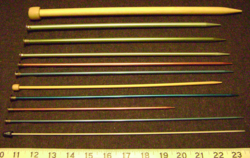
Gauge (knitting)
In knitting, the word gauge is used both in hand knitting and machine knitting; the latter, technical abbreviation GG, refers to "Knitting Machines" fineness size. In both cases, the term refers to the number of stitches per inch, not the size of the finished garment...
of the knitting and the elasticity of the fabric. Thus, a simple way to change gauge is to use different needles, which is the basis of uneven knitting. Although knitting needle diameter is often measured in millimeters, there are several different size systems, particularly those specific to the United States
United States
The United States of America is a federal constitutional republic comprising fifty states and a federal district...
, the United Kingdom
United Kingdom
The United Kingdom of Great Britain and Northern IrelandIn the United Kingdom and Dependencies, other languages have been officially recognised as legitimate autochthonous languages under the European Charter for Regional or Minority Languages...
and Japan
Japan
Japan is an island nation in East Asia. Located in the Pacific Ocean, it lies to the east of the Sea of Japan, China, North Korea, South Korea and Russia, stretching from the Sea of Okhotsk in the north to the East China Sea and Taiwan in the south...
; a conversion table is given at knitting needle
Knitting needle
A knitting needle or knitting pin is a tool in hand-knitting to produce knitted fabrics. They generally have a long shaft and taper at their end, but they are not nearly as sharp as sewing needles. Their purpose is two-fold...
. Such knitting needles may be made out of any materials, but the most common materials are metals, wood
Wood
Wood is a hard, fibrous tissue found in many trees. It has been used for hundreds of thousands of years for both fuel and as a construction material. It is an organic material, a natural composite of cellulose fibers embedded in a matrix of lignin which resists compression...
, bamboo
Bamboo
Bamboo is a group of perennial evergreens in the true grass family Poaceae, subfamily Bambusoideae, tribe Bambuseae. Giant bamboos are the largest members of the grass family....
, and plastic
Plastic
A plastic material is any of a wide range of synthetic or semi-synthetic organic solids used in the manufacture of industrial products. Plastics are typically polymers of high molecular mass, and may contain other substances to improve performance and/or reduce production costs...
. Different materials have different frictions and grip the yarn differently; slick needles such as metallic needles are useful for swift knitting, whereas rougher needles such as bamboo offer more friction and are therefore less prone to dropping stitches. The knitting of new stitches occurs only at the tapered ends. Needles with lighted tips have been sold to allow knitters to knit in the dark.

Circular knitting
Circular knitting or knitting in the round is a form of knitting that creates a seamless tube. When knitting circularly, the knitting is cast on and the circle of stitches is joined. Knitting is worked in rounds in a spiral. Originally, circular knitting was done using a set of four or five...
, especially smaller tube-shaped pieces such as sleeves, collars, and socks; usually one needle is active while the others hold the remaining active stitches. DPNs are somewhat shorter (typically 7 inch
Inch
An inch is the name of a unit of length in a number of different systems, including Imperial units, and United States customary units. There are 36 inches in a yard and 12 inches in a foot...
es) and are usually sold in sets of four or five.
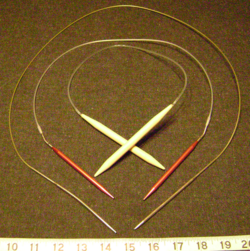
The third needle type consists of circular needles, which are long, flexible double-pointed needles. The two tapered ends (typically 5 inches (127 mm) long) are rigid and straight, allowing for easy knitting; however, the two ends are connected by a flexible strand (usually nylon) that allows the two ends to be brought together. Circular needles are typically 24-60 inches long, and are usually used singly or in pairs; again, the width of the knitted piece may be significantly longer than the length of the circular needle.
A developing trend in the knitting world is interchangeable needles. These kits consist of pairs of needles with usually nylon cables or cords. The cables/cords are screwed into the needles, allowing the knitter to have both flexible straight needles or circular needles. This also allows the knitter to change the diameter and length of the needles as needed.
The ability to work from either end of one needle is convenient in several types of knitting, such as slip-stitch
Slip-stitch knitting
Slip-stitch knitting is a family of knitting techniques that use slip stitches to make multiple fabrics simultaneously, to make extra-long stitches, and/or to carry over colors from an earlier row.-Basic methods:...
versions of double knitting
Double knitting
Double knitting is a form of knitting in which two fabrics are knit simultaneously with two yarns on one pair of needles. The fabrics may be inseparable, as in interlock knitted fabrics, or they can simply be two unconnected fabrics...
. Circular needles may be used for flat
Flat knitting
Flat knitting is a method for producing knitted fabrics in which the work is turned periodically, i.e., the fabric is knitted from alternating sides...
or circular knitting
Circular knitting
Circular knitting or knitting in the round is a form of knitting that creates a seamless tube. When knitting circularly, the knitting is cast on and the circle of stitches is joined. Knitting is worked in rounds in a spiral. Originally, circular knitting was done using a set of four or five...
.
Cable needles are a specific design, and are used to create the twisting motif of a knitted cable. They are made in different sizes, which produces cables of different widths. When in use, the cable needle is used at the same time as two regular needles. It functions by holding together the stitches creating the cable as the other needles create the rest of the stitches for the knitted piece. At specific points indicated by the pattern, the cable needle is moved, the stitches on it are worked by the other needles, then the cable needle is turned around to a different position to create the cable twist.
Record
The current holder of the Guinness World Record for Knitting with the Largest Knitting Needles is Julia Hopson of Penzance in Cornwall.Julia knitted a square of ten stitches and ten rows in stockinette stitch using knitting needles that were 6.5 centimeters in diameter and 3.5 meters long.
Ancillary tools
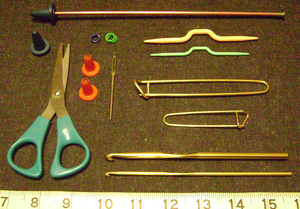
Swift (textiles)
For other uses, see Swift A swift is a tool used to hold a skein of yarn while it is being wound off. It has an adjustable diameter so that it can hold skeins of many sizes, and rotates around a central rod. They are generally made out of wood or metal, however other materials may also be used...
, ballwinder and "yarntainers". Crochet hooks and a darning needle are often useful in binding off
Binding off (knitting)
In knitting, binding off, or casting off, is a family of techniques for ending a column of stitches. Binding off is typically used to define the final edge of a knitted fabric, although it may also be used in other contexts, e.g., in making button holes...
or in joining two knitted pieces edge-to-edge
Grafting (knitting)
In knitting, grafting is the joining of two knitted fabrics using yarn and a needle in one of three types of seams:# selvage-to-selvage seam,# selvage-to-end seam, or# end-to-end seam...
. The darning needle is used in duplicate stitch (also known as Swiss darning), while the crochet hook is also essential for repairing dropped stitches
Drop-stitch knitting
Drop-stitch knitting is a knitting technique for producing open, vertical stripes in a garment. The basic idea is to knit a solid fabric, then drop one or more stitches , producing a run in the fabric...
and some specialty stitches such as tufting
Tufting
Tufting is a type of textile weaving in which a thread is inserted on a primary base.It is an ancient technique for making warm garments, especially mittens. After the knitting is done, short U-shaped loops of extra yarn are introduced through the fabric from the outside so that their ends point...
. Other tools are used to prepare specific ornaments include the pompom tree for making pompoms conveniently. For large or complex patterns, it is sometimes difficult to keep track of which stitch should be knit in a particular way; therefore, several tools have been developed to identify the number of a particular row or stitch, including circular stitch markers, hanging markers, extra yarn and row counters
Row counter (hand knitting)
A row counter for hand knitting is a tally counter for counting rows or courses worked, for counting stitch pattern repetitions, or for counting increases or decreases of the number of stitches in consecutive rows. The first commercially-produced one appeared on the market in the 1920s after the...
. A second potential difficulty is that the knitted piece will slide off the tapered end of the needles when unattended; this is prevented by "point protectors" that cap the tapered ends. Another problem is that too much knitting may lead to hand and wrist troubles; for this, special stress-relieving gloves are available. Finally, there are sundry bags and containers for holding knitting, yarns and needles.
Commercial applications
IndustriallyIndustry
Industry refers to the production of an economic good or service within an economy.-Industrial sectors:There are four key industrial economic sectors: the primary sector, largely raw material extraction industries such as mining and farming; the secondary sector, involving refining, construction,...
, metal wire
Wire
A wire is a single, usually cylindrical, flexible strand or rod of metal. Wires are used to bear mechanical loads and to carry electricity and telecommunications signals. Wire is commonly formed by drawing the metal through a hole in a die or draw plate. Standard sizes are determined by various...
is also knitted into a metal fabric for a wide range of uses including the filter material in cafetieres, catalytic converters for cars
Automobile
An automobile, autocar, motor car or car is a wheeled motor vehicle used for transporting passengers, which also carries its own engine or motor...
and many other uses. These fabrics are usually manufactured on circular knitting machine
Knitting machine
A knitting machine is a device used to create knitted fabrics in a semi- or fully automated fashion.There are numerous types of knitting machines, ranging from the simple, non-mechanical, to the highly complex and electronic. All, however, produce various types of knitted fabrics, usually either...
s that would be recognised by conventional knitters as sock
Sock
A sock is an item of clothing worn on the feet. The foot is among the heaviest producers of sweat in the body, as it is able to produce over of perspiration per day. Socks help to absorb this sweat and draw it to areas where air can evaporate the perspiration. In cold environments, socks decrease...
machines.
Many fashion designers make heavy use of knitting in their fashion collections. Gordana Gelhausen, who appeared in season six of the television show Project Runway
Project Runway
Project Runway is an American reality television series on Lifetime Television, previously on the Bravo network, which focuses on fashion design and is hosted by model Heidi Klum. The contestants compete with each other to create the best clothes and are restricted in time, materials and theme...
, is primarily a knit designer. Other designers and labels that make heavy use of knitting include Michael Kors
Michael Kors
Michael Kors is an American fashion designer. He is best known for designing classic American sportswear for women.-Personal life:...
, Fendi
Fendi
Fendi is an Italian high fashion house best known for its "baguette" handbags. It was launched in 1925 as a fur and leather shop in Rome, but today is a multinational luxury goods brand owned by LVMH...
, and Marc Jacobs
Marc Jacobs
Marc Jacobs is an American fashion designer. He is the head designer for Marc Jacobs, as well as Marc by Marc Jacobs, a diffusion line, with more than 200 retail stores in 60 countries. He has been the creative director of the French design house Louis Vuitton since 1997...
. For individual hobbyists, websites such as Etsy
Etsy
Etsy is an e-commerce website focused on handmade or vintage items as well as art and craft supplies. These items cover a wide range including art, photography, clothing, jewelry, edibles, bath & beauty products, quilts, knick-knacks and toys. Many individuals also sell craft supplies like beads,...
and Ravelry
Ravelry
Ravelry is a free social networking website, beta-launched in May 2007. It functions as an organizational tool for a variety of fiber arts including knitting, crocheting, spinning, and weaving. Members share projects, ideas, and their collection of yarn, fiber, and tools via various components...
have made it easy to sell patterns on a small scale, in a way similar to eBay
EBay
eBay Inc. is an American internet consumer-to-consumer corporation that manages eBay.com, an online auction and shopping website in which people and businesses buy and sell a broad variety of goods and services worldwide...
.
Graffiti
In the past few years, a practice called yarn bombingYarn bombing
Yarn bombing, yarnbombing, yarnstorming, guerrilla knitting, or graffiti knitting is a type of graffiti or street art that employs colorful displays of knitted or crocheted cloth rather than paint or chalk.-Method and motivation:...
, or the use of knitted or crocheted cloth to modify and beautify one's (usually outdoor) surroundings, emerged in the U.S. and spread worldwide. Magda Sayeg is credited with starting the movement in the US and Knit the City are a prominent group of graffiti knitters in the United Kingdom. Yarn bombers sometimes target existing pieces of graffiti for beautification. For instance, Dave Cole is a contemporary sculpture artist who practiced knitting as graffiti for a large-scale public art installation in Melbourne, Australia for the Big West Arts Festival in 2009. The work was vandalized the night of its completion.
Charity
Knitting garments for free distribution to others has become common practice among knitting groups. Girls and women knitted socks, sweaters, scarves, mittens, gloves, and hats for soldiers in CrimeaCrimea
Crimea , or the Autonomous Republic of Crimea , is a sub-national unit, an autonomous republic, of Ukraine. It is located on the northern coast of the Black Sea, occupying a peninsula of the same name...
, the American Civil War
American Civil War
The American Civil War was a civil war fought in the United States of America. In response to the election of Abraham Lincoln as President of the United States, 11 southern slave states declared their secession from the United States and formed the Confederate States of America ; the other 25...
, and the Boer Wars; this practice continued in World War I
World War I
World War I , which was predominantly called the World War or the Great War from its occurrence until 1939, and the First World War or World War I thereafter, was a major war centred in Europe that began on 28 July 1914 and lasted until 11 November 1918...
, World War II
World War II
World War II, or the Second World War , was a global conflict lasting from 1939 to 1945, involving most of the world's nations—including all of the great powers—eventually forming two opposing military alliances: the Allies and the Axis...
and the Korean War
Korean War
The Korean War was a conventional war between South Korea, supported by the United Nations, and North Korea, supported by the People's Republic of China , with military material aid from the Soviet Union...
, and continues for soldiers in Iraq and Afghanistan
War in Afghanistan (2001–present)
The War in Afghanistan began on October 7, 2001, as the armed forces of the United States of America, the United Kingdom, Australia, and the Afghan United Front launched Operation Enduring Freedom...
. In the historical projects, yarn companies provided patterns approved by the various branches of the armed services; often they were distributed by local chapters of the American Red Cross
American Red Cross
The American Red Cross , also known as the American National Red Cross, is a volunteer-led, humanitarian organization that provides emergency assistance, disaster relief and education inside the United States. It is the designated U.S...
. Modern projects usually entail the knitting of hats or helmet liners; the liners provided for soldiers must be of 100% worsted weight wool and be crafted using specific colors.
Clothing and afghans are frequently made for children, the elderly, and the economically disadvantaged in various countries. Pine Ridge Indian Reservation
Pine Ridge Indian Reservation
The Pine Ridge Indian Reservation is an Oglala Sioux Native American reservation located in the U.S. state of South Dakota. Originally included within the territory of the Great Sioux Reservation, Pine Ridge was established in 1889 in the southwest corner of South Dakota on the Nebraska border...
accepts donations for the Lakota people in the United States.
Prayer shawls, or shawls in which the crafter meditates or says prayers of their faith while knitting with the intent on comforting the recipient, are donated to those experiencing loss or stress.
Many knitters today knit and donate "chemo caps," soft caps for cancer patients who lose their hair during chemotherapy
Chemotherapy
Chemotherapy is the treatment of cancer with an antineoplastic drug or with a combination of such drugs into a standardized treatment regimen....
. Yarn companies offer free patterns for these caps.
Penguin sweater
Penguin sweater
Penguin sweaters, also known as penguin jumpers, are sweaters which are knitted for penguins that have been caught in oil slicks. When an oil spill affects penguins, they are dressed in knitted sweaters to stop them preening their feathers and to keep them warm, since the spilled oil destroys their...
s were knitted by volunteers for the rehabilitation of penguins contaminated by exposure to oil slicks. The project is now complete.
Chicken sweaters were also knitted to aid battery hens that had lost their feathers. The organization is not currently accepting donations, but maintains a list of volunteers.
Originally started after the 2004 Indonesian tsunami, Knitters Without Borders is a charity challenge issued by knitting personality Stephanie Pearl-McPhee
Stephanie Pearl-McPhee
Stephanie Anne Pearl-McPhee is a writer, knitter, or International Board Certified Lactation Consultant, and doula living in Toronto, Ontario, Canada.-Life:...
that encourages knitters to donate to Médecins Sans Frontières
Médecins Sans Frontières
' , or Doctors Without Borders, is a secular humanitarian-aid non-governmental organization best known for its projects in war-torn regions and developing countries facing endemic diseases. Its headquarters are in Geneva, Switzerland...
(Doctors Without Borders). Instead of knitting for charity, knitters are encouraged to a week’s worth of disposable income, including money that otherwise might have been spent on yarn. Knitted items are occasional offered as prizes to donors. As of September 2011, Knitters Without Borders donors have contributed CAD$1,062,217.
See also
- Finger knittingFinger knittingFinger knitting is a simple form of knitting in which yarn is knitted into a shorter but thicker twine. As its name suggests, the knitting only uses the hands during the entire process.-Uses:...
- Knitted fabricKnitted fabricKnitted fabrics is the third major class of fabric, after woven and nonwoven fabrics.-Elasticity, thickness and warmth:Compared to the other two classes, knitted fabrics are much more elastic, which accounts for their historical use in stockings and other clothing that requires changes in shape...
- Knitting Guild AssociationKnitting Guild AssociationThe Knitting Guild Association is the largest knitting association in the United States. It has 10,000 members in the United States and abroad, and is dedicated to promoting knitting and knitting education. Members are individual knitters, and there are also local guilds who belong to TKGA. To...
- Knitting clubsKnitting clubsKnitting clubs are a feature of the recent revival of hand knitting which began in America and has spread to most of Europe. Despite the name, knitting clubs are not limited to knitting: both crochet-centered and knit-centered clubs are collectively called "knitting clubs." While some may say...
- Textile manufacturingTextile manufacturingTextile manufacturing is a major industry. It is based in the conversion of three types of fibre into yarn, then fabric, then textiles. These are then fabricated into clothes or other artifacts. Cotton remains the most important natural fibre, so is treated in depth...
- Yarn bombingYarn bombingYarn bombing, yarnbombing, yarnstorming, guerrilla knitting, or graffiti knitting is a type of graffiti or street art that employs colorful displays of knitted or crocheted cloth rather than paint or chalk.-Method and motivation:...
Additional reading
- Hiatt, June Hemmons. (1988). The principles of knitting: Methods and techniques of hand knitting. Simon and Schuster, New York.
- Rutt, Richard (2003). A History of Hand Knitting. Interweave Press, Loveland, CO. (Reprint Edition ISBN)
- Stoller, DebbieDebbie StollerDebbie Stoller is a New York Times best-selling American author, publisher and feminist pundit whose work includes magazines as well as books. She lives in Brooklyn, New York City, New York....
. (2004) Stitch 'n Bitch: The Knitter's Handbook. Workman Publishing Company - Thomas, Mary. (1938). Mary Thomas's Knitting Book. Dover Publications. New York. (1972 Reprint Edition ISBN)
- Zimmermann, ElizabethElizabeth ZimmermannElizabeth Zimmermann was a British-born knitter known for revolutionizing the modern practice of knitting through her books and instructional series on American public television....
. (1972). Knitting Without Tears. Simon and Schuster, New York. (Reprint Edition ISBN) - Gschwandtner, Sabrina. (2007). KnitKnit: Profiles and Projects from Knitting's New Wave. Stewart, Tabori and Chang, New York.
- Knitty Gritty - Knitting for the Absolute Beginner by Aneeta Patel. A&C Black 2008
External links
- craftyarncouncil.com, Relationship between yarn weight and knitting gauge.
- US and UK Conversion Chart Shows US and UK conversion charts, relationship to needle size and typical usage.

